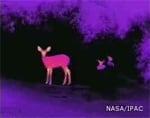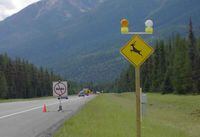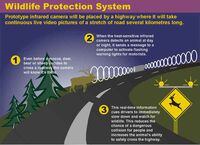A heat-sensing technology developed by NASA to target incoming missiles has an application that could prevent some of the thousands of vehicle-wildlife collisions that occur every year in the US, killing dozens of motorcyclists and injuring many more.
InTransTech Corporation uses a state-of-the-art infrared camera to detect and identify wildlife along roadways. When an animal is sensed approaching a stretch of roadway monitored by the detector, the system sends a signal to the alerting display. The display consists of flashing lights on a deer-warning or similar sign, which warn motorists to slow. The sensors can detect an animal even before it reaches the open area along the road. The company's website shows a more advanced display that can even tell about what kind of animal is near the road.
There has been a notable increase in vehicle-wildlife accidents this year, and several states have warned that deer are a growing hazards for motorists (they might also warn the deer, but they don't seen to pay attention). We have already read numerous reports of motorcyclists who were seriously injured or killed in collisions with deer and moose this summer, and readers from northern Midwest states have commented on how common close calls with deer have become. Insurance losses for all incidents are said to exceed $1 billion a year. Of course, the wildlife usually fare worse than the vehicle occupants, with about half a million deer killed by vehicles every year in the U.S. That's why InTransTech ("Intelligent Transportation Technology") actually refers to the system as a "Wlidlife Protection System."
Though it probably isn't feasible to cover all potential wildlife habitats along roadways with the InTransTech system in the near future, many heavily used migration paths could presumably be monitored. InTransTech tells us that there is one system currently deployed in Kootenay National Park in British Columbia, Canada. That system is in its second year of deployment and is used for testing and improvements in preparation for going into production. The cost of deploying the system will vary with the site, with considerations like the availability of electric power playing a major role. The Insurance Corporation of British Columbia has provided funding for the project.
In the meantime, if you see a deer-crossing sign with flashing lights, slow down immediately.



/cloudfront-us-east-1.images.arcpublishing.com/octane/DTN6JPXIQJFXPBR43K4GWBDYJ4.jpg)
/cloudfront-us-east-1.images.arcpublishing.com/octane/PDJNVOWK5VFEBKBUG32CWZEAFI.jpg)
/cloudfront-us-east-1.images.arcpublishing.com/octane/URZBW5LIV5BIXMBTOKHIDHMIPM.jpg)

/cloudfront-us-east-1.images.arcpublishing.com/octane/6KKT5NNL2JAVBOXMZYS5ZO76YA.jpg)
/cloudfront-us-east-1.images.arcpublishing.com/octane/H6Z2IC7WYRBXZNQS4MI3SZ5KPQ.jpg)
/cloudfront-us-east-1.images.arcpublishing.com/octane/IWO5T5PBT5E4HFQ5GK47H5YXR4.jpg)
/cloudfront-us-east-1.images.arcpublishing.com/octane/OQVCJOABCFC5NBEF2KIGRCV3XA.jpg)
/cloudfront-us-east-1.images.arcpublishing.com/octane/F3O2DGLA4ZBDJGNVV6T2IUTWK4.jpg)
/cloudfront-us-east-1.images.arcpublishing.com/octane/ZXYQE3MHLFDSPKNGWL7ER5WJ4U.jpg)
/cloudfront-us-east-1.images.arcpublishing.com/octane/RDF24VM7WVCOBPIR3V3R4KS63U.jpg)
/cloudfront-us-east-1.images.arcpublishing.com/octane/W7RSIBFISNHJLIJESSWTEBTZRQ.jpg)
/cloudfront-us-east-1.images.arcpublishing.com/octane/AERA26ENRNBW3K324YWCPEXYKM.jpg)
/cloudfront-us-east-1.images.arcpublishing.com/octane/YWX3YX7QBBHFXFDMEEEKRG4XJE.jpg)
/cloudfront-us-east-1.images.arcpublishing.com/octane/I7OKI53SZNDOBD2QPXV5VW4AR4.jpg)
/cloudfront-us-east-1.images.arcpublishing.com/octane/IH52EK3ZYZEDRD3HI3QAYOQOQY.jpg)
/cloudfront-us-east-1.images.arcpublishing.com/octane/K2FSAN7OWNAXRJBY32DMVINA44.jpg)
/cloudfront-us-east-1.images.arcpublishing.com/octane/G4XK7JL24FCUTKLZWUFVXOSOGE.jpg)
/cloudfront-us-east-1.images.arcpublishing.com/octane/JJNXVAC27ZCDDCMTHTQZTHO55Y.jpg)




